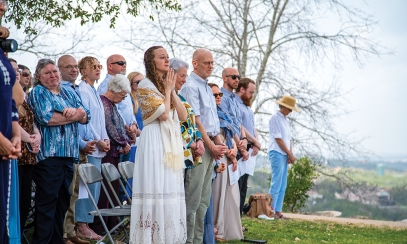
The Season of Lent
Lent is an Invitation to Grow With the Lord
Lent is an Invitation to Grow With the Lord
Lent is upon us! May these 40 days prior to the great celebration of Easter bring us closer to Christ. In his 2021 message for Lent, Pope Francis wrote, “The call to experience Lent as a journey of conversion, prayer and sharing of our goods, helps us – as communities and as individuals – to revive the faith that comes from the living Christ, the hope inspired by the breath of the Holy Spirit and the love flowing from the merciful heart of the Father.”
Every year during Lent, many of the same questions arise. Here are a few that I have been answering lately.
What is Lent and when does it start?
Lent is the 40-day season that began on Ash Wednesday (March 2) and ends at sundown on Holy Thursday (April 14). Sidenote: these dates change every year because the date of Easter changes every year. Lent is a period of preparation for those who will be baptized at Easter. For those of us already baptized, Lent is a season that invites us to prepare for Easter and the celebration of the Resurrection of the Lord. Lent is an invitation to conversion and growth in our lives with the Lord.
Why does my church look different during Lent?
During Lent, you might notice that the church looks different than the weeks before. The liturgical color is purple and there are no flowers around the altar. This is because Lent is a penitential season. The color purple is the color of penance and a reminder that things are not the same as before. The lack of flowers and less festive decorations in the church reminds us that Lent is a time of prayerful reflection and repentance.
During Holy Week (Palm Sunday through the Easter Vigil), the church will change how it looks a few more times. You will notice the colors changing again (red on Palm Sunday and Good Friday, white on Holy Thursday). On Holy Thursday there may be flowers again as well. These changes again reflect the changing nature of the liturgical celebration of the day.
What is fasting?
Fasting means a person is permitted one small meal a day with two smaller meals permitted, if necessary. The two smaller meals should not equal the size of the large meal. Water is always permitted.
Do I have to fast?
On Ash Wednesday and Good Friday, Catholics between the ages of 18 and 59 are obliged to fast, except if they are not able to safely do so due to health reasons (for example, if one is pregnant or has an illness).
Can I eat meat during Lent?
Catholics over the age of 14 are obliged to abstain from meat on Fridays during Lent and on Good Friday.
Why don’t we sing the Gloria and Alleluia in Mass during Lent?
The Gloria and Alleluia are both songs of joy and praise. Due to the penitential nature of Lent, we refrain from these outward signs of joy to help us enter more deeply into the season of Lent. This will also make the joyful singing of them at Easter all the more powerful and meaningful.
However, there are exceptions: they can be sung at Ritual Masses and solemnities (such as the feasts of the St. Joseph or the Annunciation) because they are days of great solemnity and joy in the church.
Do I have to go to confession during Lent?
One of the precepts of the church is to confess one’s sins and receive the sacrament of reconciliation (confession) at least once a year. While every Catholic is encouraged to take advantage of the sacrament as often as needed, Lent provides an opportunity to prepare ourselves more fully to celebrate the Resurrection of Christ at Easter. (see the box for more information on how to go to confession).
What are the “marks of Lent”?
The “marks of Lent” are the traditional practices associated with the season of Lent: prayer, fasting and almsgiving. All three are rooted in Scripture and provide us with ways to grow closer to God.
Prayer is a conversation with God. It should always be at the heart of our spiritual life. Prayer is essential when we observe fasting and almsgiving because it ensures that they are rooted in God and not our own sense of self.
We often think of fasting as giving up food, and we do fast in that sense at points during Lent, as well as abstain from eating meat. However, fasting is about more than food. It is an early practice of the church, which also has roots in the Jewish faith. It helps us see our dependence on God for our very lives. It is a noble practice to “fast” from things that are not bringing us closer to God: gossip, being quick to judge others, consuming media that is not edifying, etc. All of these things help us remember that we need to be focused first on God and his care for us and that we should hunger for him.
Almsgiving is a natural outgrowth from the reality that prayer and fasting remind of our total dependence on God and on his love for us as his children. Almsgiving allows us to show our gratitude to God for all he has given us and is an outward show of the love we have for our neighbors as children of God.
For more resources about Lent, visit the diocesan website at www.austindiocese.org/resources-for-lent.
A refresher on how to go to confession
For those who may need a reminder, here is how to receive the sacrament of confession/reconciliation.
- Find a time and place to go to confession. Most parishes offer the sacrament at least once a week. During Lent, parishes often have a penance service in which several priests are available to offer the sacrament.
- Prior to going to confession, examine your conscience. Reflect on your sins, both things you have done and said and things you have not done and said. There are numerous way to examine your conscience, but one good one is by reflecting on the 10 commandments and how you have or have not followed them.
- Upon entering the confessional, begin with the Sign of the Cross saying, “In the name of the Father, and of the Son, and of the Holy Spirit. Bless me Father for I have sinned. It has been [length of time] since my last confession. These are my sins …”
- The priest may offer some guidance, and he will give you a penance (sometimes a prayer or a reading). Your penance is to be done after you leave the confessional.
- Pray the Act of Contrition out loud. This shows that you are sorry for your sins. Often the words of the Act of Contrition are printed in the confessional or you can ask the priest to help you say it.
- The priest will then raise his hands above your head and offer the Prayer of Absolution to which you respond “Amen.”
- The priest may offer some words of comfort and acknowledgment that God has forgiven your sins and then add a dismissal. You can respond “Thanks be to God” or in some other appropriate manner.
- Leave the confessional and find a quiet place to do your penance (if appropriate).



